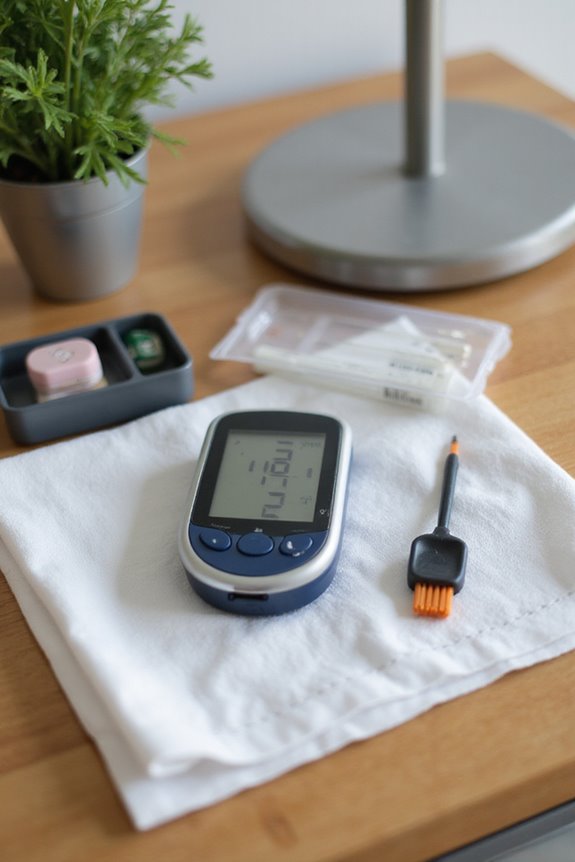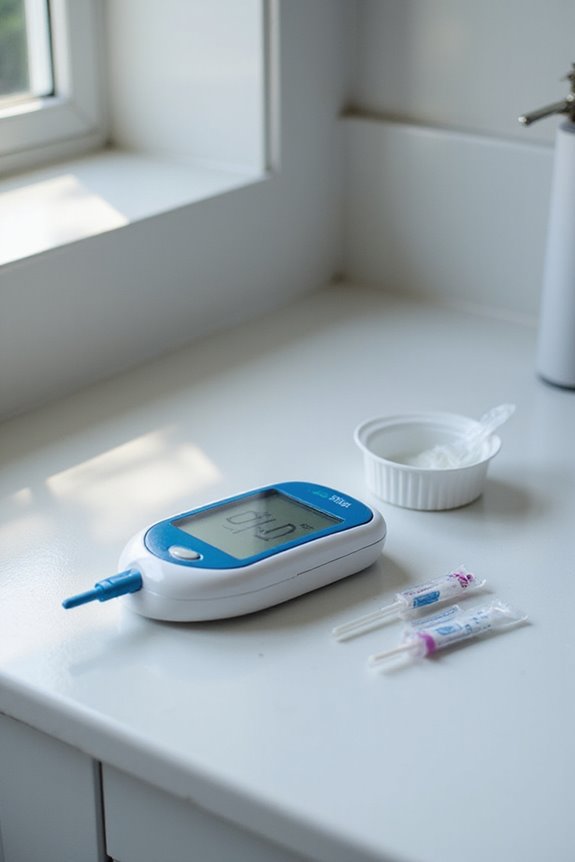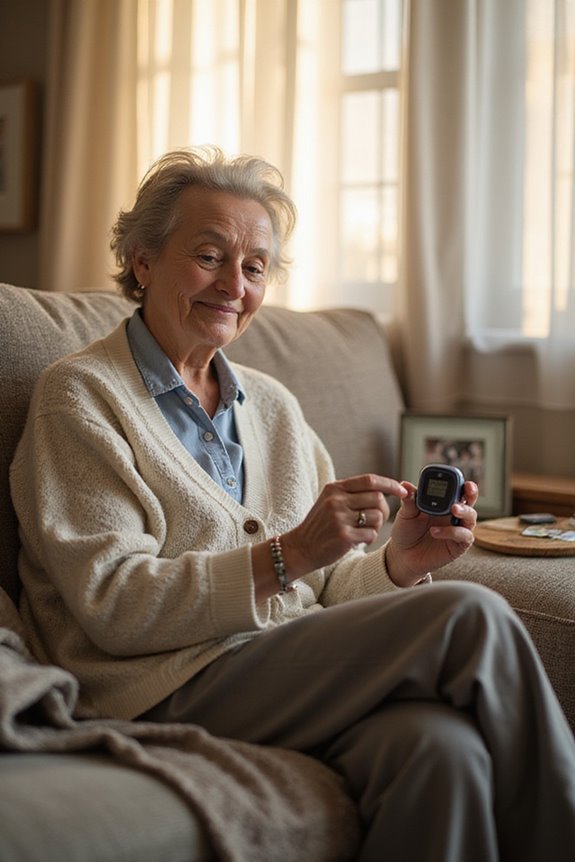To use a blood glucose meter, one must gather necessary materials: a glucose meter, test strips, lancet device, alcohol swabs, and gauze pads. Preparation includes cleaning a finger, typically the index, middle, or ring, and allowing it to air dry. After inserting a test strip, puncture the finger and apply blood. Record the reading and dispose of materials properly. Regular checks and professional support can enhance meter use and patient outcomes. Further instruction on advanced techniques follows.
Key Takeaways
- Prepare necessary materials: glucose meter, test strips, lancet device, and cleaning supplies.
- Select and clean a finger for blood sampling, ensuring it’s well-vascularized.
- Insert a test strip into the glucose meter, and confirm calibration code.
- Puncture the fingertip, apply blood to the strip, and log results immediately.
- Dispose of used materials properly and wash hands to maintain hygiene.
Preparation and Necessary Materials
Preparation for blood glucose testing requires careful attention to necessary materials and equipment. Essential components include:
- Glucose meter designed for home or clinical use.
- Compatible test strips, verified for expiration and stored properly.
- Lancet device with fresh lancets for blood sampling.
- Alcohol swabs or neutral wipes for site cleaning, if necessary.
- Dry swabs or gauze pads for post-testing care, alongside a puncture-proof container for disposal.
Test strip verification is critical; the meter must be calibrated correctly by matching the code on the test strip box with the meter display code. This guarantees accurate readings. Proper preparation facilitates a smooth workflow, reducing the risk of errors, and promoting effective management of blood glucose levels. Additionally, choosing a meter with minimal blood sample requirements can enhance user comfort and convenience.
Hand and Finger Preparation
Effective hand and finger preparation is essential for accurate blood glucose testing.
Finger Selection: Choose the index, middle, or ring fingers for testing. Avoid the thumb and pinky due to callus formation.
Cleaning Techniques: Clean the selected finger with an alcohol wipe, ensuring it is free from lotions and oils. Allow the area to air dry completely, avoiding wipes with additives. Alternatively, use a neutral wipe for alcohol-free cleaning.
Positioning: Position the hand in a dependent manner, ensuring the finger is relaxed. A firm grip provides stability, and a steady surface can support the hand. Proper preparation promotes reliable results, fostering confidence in managing blood glucose levels effectively. Additionally, using a user-friendly design can enhance the ease of testing and improve overall accuracy.
Blood Sample Collection

Blood sample collection follows the critical steps of hand and finger preparation, guaranteeing accurate glucose measurements.
Choosing the Puncture Site****
- Preferred site: lateral side of the finger pad, avoiding the central tip
- Reduces pain and injury risk by avoiding dense nerves
- Confirm well-vascularized site for adequate blood sample
- Avoid calloused areas for reliable results
- Rotate sites to prevent scarring and inaccurate results
Lancets and Needle Devices
- Use sterile, single-use lancets
- Set to the lowest depth for an adequate blood droplet
- Quick insertion against the finger’s side
Collecting the Blood Sample
- Firmly press and trigger the lancet
- Wipe away the first droplet
- Collect a small, adequate-sized droplet for testing. Additionally, using sterile, single-use lancets ensures a hygienic process and minimizes the risk of infection.
Operating the Glucose Meter

Operating a glucose meter involves several precise steps to guarantee accurate monitoring of blood glucose levels.
Preparing the Meter:
- Remove a test strip from its packaging just before use.
- Insert the strip into the meter, which usually powers on automatically.
- Check that the displayed code matches the test strip container for meter calibration.
- Confirm the date and time settings are accurate.
Configuring the Lancing Device:
- Insert a sterile lancet and adjust the depth setting based on skin thickness.
- Prime the device as instructed.
Performing the Test:
- Wash hands thoroughly.
- Puncture the selected fingertip, then apply blood to the test strip.
- Wait for the meter to display results, ensuring all device features function correctly. This includes checking the meter’s data storage capabilities, which are essential for effective trend analysis and long-term glucose tracking.
Post-Testing Procedures

Recording and Tracking Results:
- Log results immediately, including date, time, and contextual factors.
- Use digital tools or smartphone apps for automatic tracking.
- Review logs regularly to identify trends. Incorporating digital tools can significantly enhance the efficiency and accuracy of your tracking process.
Safe Disposal of Testing Materials:
- Dispose of lancets and used test strips immediately in puncture-proof containers.
- Wash hands post-disposal to maintain post-test hygiene.
Result Interpretation:
- Compare readings against target ranges from healthcare providers.
- Consult a healthcare professional if results are consistently outside the target range.
- Monitor for ketones if blood glucose levels are considerably elevated.
Storage and Maintenance of Equipment
Proper storage and maintenance of blood glucose meters and associated supplies are essential for ensuring their reliability and accuracy.
Temperature Management
- Insulin should remain within specified temperature ranges; unopened vials must be refrigerated.
- Test strips require protection from humidity, extreme temperatures, and direct sunlight.
Cleaning and Disinfection Protocols
- Clean glucometers with manufacturer-recommended disinfectants, ensuring they are dry before storage.
- Clearly label disinfection containers with contact time information.
Periodic Inspection and Calibration
- Conduct weekly checks with control solutions for accuracy.
- Inspect meters annually for structural issues and replace as necessary.
Contamination Prevention
- Assign individual meters to patients, using labeled storage bags to minimize cross-contamination.
- Adhere to strict hand hygiene practices before handling equipment.
- Regularly check the accuracy of measurements to ensure reliable results from your glucose meter.
Understanding Blood Glucose Readings
Understanding blood glucose readings is essential for effective diabetes management. Accurate blood glucose interpretation relies on recognizing normal ranges, which typically are 70 to 140 mg/dL for healthy individuals. For those with diabetes, target levels are generally 80 to 130 mg/dL before meals and less than 180 mg/dL post-meal.
Key points include:
- Meters provide numerical values in mg/dL, often accompanied by trend arrows indicating glucose direction.
- Meter calibration is vital for reliable readings and avoiding false results.
- Recognizing patterns, such as rising trends before meals or falling trends post-meal, can inform necessary adjustments. Additionally, using no coding technology in blood glucose test strips can enhance accuracy and reliability in your readings.
Consistent monitoring and understanding these metrics empower individuals to make informed decisions regarding their health and treatments.
Troubleshooting Common Issues
Troubleshooting common issues with blood glucose meters is vital for guaranteeing accurate readings and effective diabetes management. Users should be aware of frequent error messages, such as “Sensor Already in Use” or “Check Sensor,” which often indicate calibration issues or improper sensor application.
To avoid inaccurate results, it is essential to:
- Fully insert test strips before use.
- Maintain an upright meter position during blood application.
- Replace batteries every few years to uphold reliability.
- Store test strips in suitable conditions.
Temperature extremes or contamination from unwashed hands can also affect accuracy. Regularly check for display and performance problems, as these may require reporting to the manufacturer for proper guidance or replacement. Additionally, ensure that your meter complies with ISO standards for reliable readings and consistency in blood sugar monitoring.
Seeking Professional Support and Education
Seeking professional support and education is essential for healthcare providers aiming to enhance their expertise in blood glucose monitoring technologies. Structured professional training programs focus on continuous glucose monitoring (CGM) systems, including calibration and trend interpretation.
Key components of these programs include:
- Certification Programs: Offer formal recognition for skills in diabetes technology and glucose monitoring.
- CME Activities: Provide credits for focused CGM training, ensuring ongoing professional development.
- Hands-on Training: Facilitates learning about advanced therapy management and data analysis.
These educational opportunities empower healthcare providers to match patients with appropriate glucose monitoring technologies, addressing individual needs and preferences, ultimately improving patient care and self-management outcomes.
Frequently Asked Questions
How Often Should I Test My Blood Glucose Levels?
The testing frequency for blood glucose levels varies by diabetes type and treatment. Ideal times include fasting, before meals, and occasionally at bedtime, ensuring tailored management and promoting a sense of community among those maneuvering similar challenges.
Can I Test Blood Glucose on Other Body Parts?
Studies show fingertip testing offers over 90% accuracy, while alternate testing sites may lag in responsiveness. Individuals often opt for these sites to minimize discomfort, but must verify meter compatibility to guarantee reliable readings.
What Factors Can Affect My Blood Glucose Readings?
Various factors influence blood glucose readings, including dietary choices and stress levels. Consuming high carbohydrates or experiencing emotional stress can lead to fluctuations, highlighting the importance of mindful eating and stress management for stable results.
Are There Any Side Effects From Frequent Finger Pricking?
Frequent finger pricking can lead to pain, skin sensitivity alterations, and emotional distress. Over time, individuals may experience discomfort and reduced sensitivity in their fingertips, potentially impacting their willingness to monitor blood glucose regularly.
How Should I Handle Glucose Meter Errors During Testing?
Facing glucose meter errors can feel like steering through a stormy sea. Effective error troubleshooting includes checking meter calibration, using fresh strips, and maintaining ideal conditions to guarantee accurate readings and foster a sense of control and belonging.




